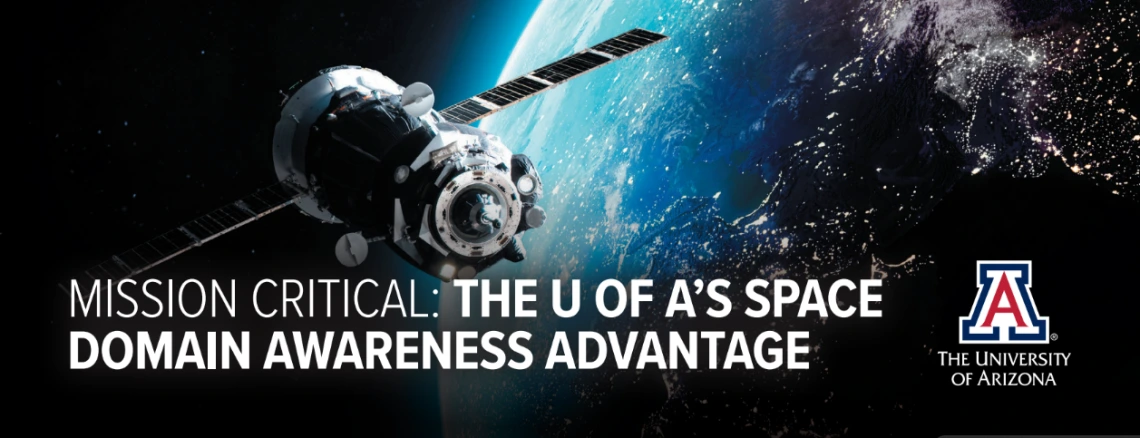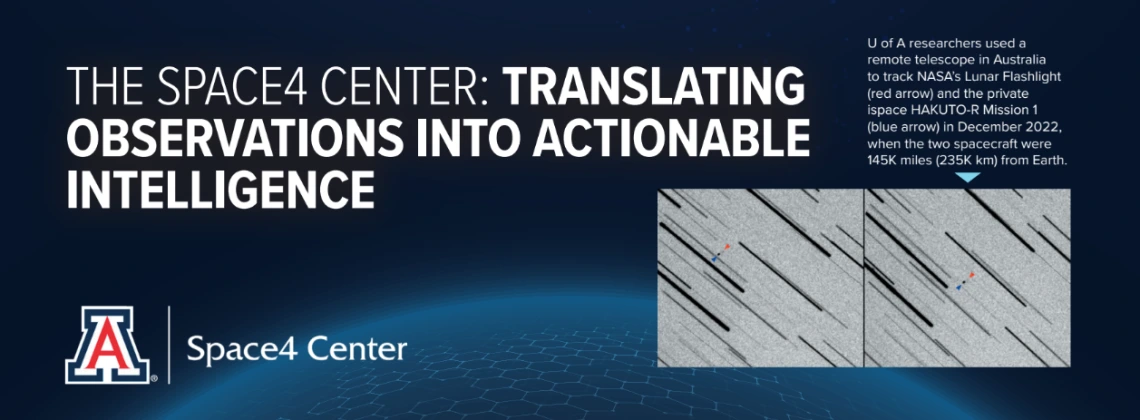Space Domain Awareness
University of Arizona scientists monitor and study objects in Earth orbit and beyond to ensure awareness of intentional or unintentional changes in orbital trajectories.
To propel the next wave of space exploration and deepen our understanding of solar system formation, NASA's OSIRIS-REx mission, led by Dante Lauretta, Ph.D. (Principal Investigator and Regents Professor of Planetary Sciences), has unveiled primordial ingredients in the dust samples collected from asteroid Bennu. These findings offer new insights into our solar system's formation and Earth's origins.
In related efforts, Erika Hamden (Director of the Space Institute and Associate Professor of Astrophysics) discussed NASA’s Landolt mission with Techopedia. This mission aims to create a perfect artificial star using laser technology—a critical step toward detecting habitable worlds similar to Earth in space.
Collaborating with an international team, Ilaria Pascucci, Ph.D. (Professor of Lunar and Planetary Sciences and co-author), utilized the James Webb Space Telescope to study the gas and dust disk around a low-mass star. Their research revealed the largest array of carbon-containing molecules ever observed in such a young system, further enhancing our understanding of planetary formation.
These breakthrough discoveries underscore the importance of continued investment in space missions. The University of Arizona-led OSIRIS-REx mission, under NASA, collected sample material from the 4.5-billion-year-old asteroid Bennu, which revealed evidence of water and high carbon content. According to Lauretta in a discussion with The Washington Post, these findings are crucial as they may offer insights into the origin of life.
Additionally, Vishnu Reddy (Director of the Space4 Center and Professor of Planetary Sciences in the Lunar and Planetary Lab) and his Space4 team identified errant space junk that crashed into the Moon, definitively proving it to be a booster from a Chinese space rocket.
In the fall of 2022, the University of Arizona launched the Space4 Center to consolidate the expertise of researchers in science and engineering. Space4 empowers its collaborators by developing cyber tools and resources for the responsible use of the Earth-Moon system and exploring cislunar space. The center offers expertise in discovery, tracking, and characterization, as well as in astrodynamics, machine learning, data visualization, and workforce development.

The Strategic High Ground: Enhancing U.S. Space Superiority
The University of Arizona in Tucson is a mission-ready partner in strengthening U.S. space domain awareness. Our work extends to the under-observed cislunar region to help prevent strategic surprises, counter potential threats, support allies, protect national security and reduce risks to lunar missions.
Through the Space4 Center, versatile global optical assets, and AI-powered analytics, we deliver capabilities that align with national priorities to ensure freedom of operation in space and support a layered defense strategy.
U of A Highlights: At a Glance
- #2 in Astronomy / Astrophysics in R&D expenditures
- #6 in NASA-funded activity among public universities
- $1B projected in FY24 research activity
- #7 in Physical Sciences funding in R&D expenditures
- Largest academic SDA network
- GEO positional accuracy under 50 m
- Top 20 research expenditures among public universities
- Detecting objects as small as 16 in. in GEO
- Tracking >3-in. debris in LEO
- >13 unique optical, IR and passive RF sensors worldwide
- Detecting objects >40 in. in cislunar space
Select Proven U of A Achievements in Space Defense
- Cislunar SDA Leadership: $7.5M AFRL-funded research advancing cislunar tracking and object identification.
- Lunar Impact Verification: Identified the presumed SpaceX Falcon 9 rocket booster that hit the moon in 2022 as Chang’e 5-T1, a Chinese booster from a 2014 rocket launch.
- Spectral Analysis: Confirmed that an unknown object, later identified as 2020 SO, was a remnant of the 1966 NASA Surveyor 2 mission.
- Proven Optical Collection in the Cone of Shame: Achieved spacecraft tracking within 2° of the Moon using Raven-class telescopes.
- Spectral Fingerprinting: First-of-its-kind spectral signature database of artificial space materials.
- AI for Space Operations: Part of an international partnership that is using AI to help predict and avoid collisions with space debris.

Mission Focused
The Space4 Center combines the university’s moonshot culture with the brightest minds in space surveillance, astrodynamics, machine learning, and data science to provide end-to-end capabilities, from threat detection to attribution.
Core Capabilities
- Continuous Observing & Monitoring: Uses optical, IR, and passive RF sensors.
- Autonomous Sensor Tasking & Scheduling: AI-optimized telescope operations for rapid response, maximizing coverage of priority targets.
- Spectral Material Identification: Laboratory-validated analysis of space object materials using visible wavelength spectral data.
- Predictive Modeling & Trajectory Forecasting: AI/ML-enhanced forecasting of satellite maneuvers and non-cooperative object tracking.
- Cislunar Object Detection & Cataloging: Building the first academic cislunar catalog to support lunar space traffic management and address the surveillance gap where SDA legacy systems fail.
- Multi-Sensor Data Fusion & Attribution: Combining optical, radar, and spectral data streams to improve orbit determination, maneuver detection, and anomaly analysis.
- Student-Operated SDA Facility: 47 graduate students and postdocs have had hands-on training in real-world SDA operations and AI applications at the Space4 Center Space Domain Awareness Observatory.
Strategic Partners
• AFRL • U.S. Space Force • NASA • UK Space Agency • FVEY Partners • Raytheon Missiles and Defense • MIT • University of Hawaii • UT, Austin • University of Western Australia • University of Strathclyde, Scotland • Cerro Tololo Inter-American Observatory, Chile • Universidad Politécnica de Madrid
